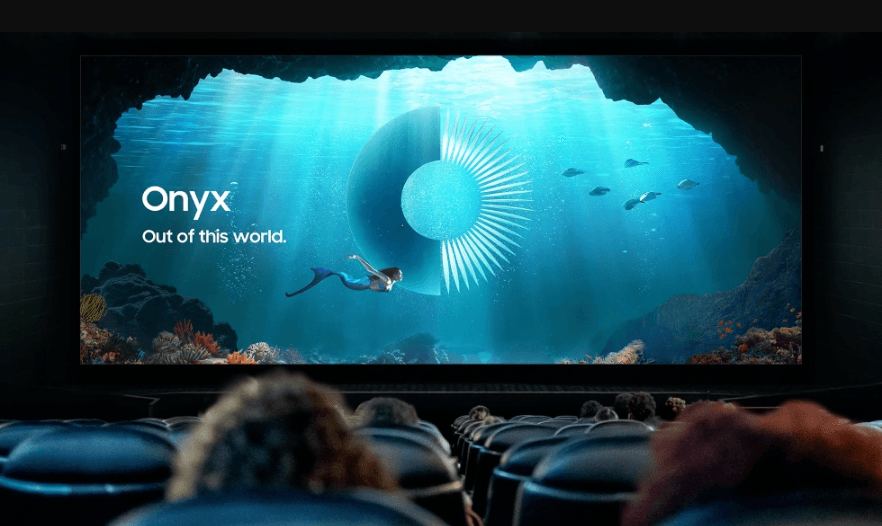
Samsung Electronics is looking to drag the cinema industry into a new age of cutting-edge display screens and replace the decades-old projection technology it has long relied on.
The company doubled-down on that push at this week’s CinemaCon 2025 event, where it unveiled its latest-generation Onyx LED modular cinema screens, which can be used to build widescreen cinema screens of up to 20 metres diagonally.
Moreover, the new displays feature more advanced technology, supporting HDR-quality movies at up to 120 frames per second, the company said.
The new Onyx LED displays are said to be “true LED screens” without LCD panels. They’re a modular display technology, and multiple LED modules can be fitted together to create much larger displays in a range of different sizes. Samsung said they’re DCI-certified for use in cinemas, and support SDR as well as HDR, unlike most projectors used in cinemas today.
Samsung installed its first-ever Onyx LED cinema screens in Europe and South Korea way back in 2017, and so it’s effort to disrupt the industry is taking some time to come to fruition, but it will be hopeful of getting more cinemas interested in the idea of LED displays with its latest offerings.
The company claims that LED displays enable deeper blacks, higher contrast and more accurate colour reproduction than the traditional projectors used in cinemas today. Moreover, they can support HDR quality content at up to 4K 120Hz, so long as the video decoding and processing system used also supports it. In addition, Samsung specifies a peak brightness of 300 nits – and while that may not sound like a lot, at least not compared to some modern living room TVs, it’s much brighter than any existing cinema screen. At present, Dolby Cinemas are the brightest in the business, at just 108 nits.
Whether Samsung’s gambit pays off remains to be seen. Until now, very few filmmakers have attempted to embrace high frame rates in cinemas, with the majority of films being shot and shown at just 24 fps. Even the most adventurous movies, such as Avatar: The Way of Water, were only delivered at just 48 fps.
That said, Samsung has a few supporters of its idea to bring HDR to cinema screens, with one of them being Pixar Studios, which has produced multiple films in HDR quality, such as Inside Out 2 and Elemental. Its upcoming summer movie, Elio, is set to be displayed in HDR on Samsung’s LED screens at a limited selection of cinemas.
Pixar’s senior scientist Dominic Glynn said the company has become a pioneer of HDR-1 theatrical releases because it sees cinema as a grand experience where “stories feel larger than life”, and where “memories are made with friends”.
"In rising to meet this ambition, Samsung’s Onyx screen technology delivers astonishing brightness, clarity, and colour — an image so clear and uniform it elevates every moment of the story,” Glynn said. “Even the casual moviegoer will feel the difference. It’s about creating that unforgettable kind of experience that reminds us why cinema is, and always should be, special."
While Pixar’s support is certainly notable, it’s also notable that the company hasn’t yet made any movies in the higher frame rates that Samsung is pitching to cinemas and movie makers.

One thing that cinemas may find appealing is the customisable nature of Samsung’s new Onyx LED displays. Because they’re modular, installation is extremely flexible, the company said.
It’s offering four different sizes, including 5 metre displays with a pixel pitch of just 1.25 millimetres for boutique and small-format theatres, and 10 metres with a 2.5mm pixel pitch, which is the standard found in most cinemas today. It also offers a 14 metre display with a 3.3mm pixel pitch for more immersive, large-scale cinematic experiences, and maxes out at 20 metres with a 5.0mm pixel pitch for “premium auditoriums”.
In addition, Samsung also points out that the new LED displays support both 2.39:1 and 1.85:1 aspect ratios.
The company said the first new Onyx LED cinema displays will be installed in the autumn, with one location being the Cannon Beach mixed-use development in Mesa, Arizona, in the U.S. It’s not clear if any Samsung LED cinemas are going to be installed in the U.K.
Samsung’s Hoon Chung, an executive vice president of the Visual Display business, said he believes there will be strong demand for the new displays as the cinema industry strives to deliver more immersive and captivating experiences.
"With Onyx, Samsung delivers not only the highest-quality visuals but also the flexibility that allows theaters to redefine the movie-going experience and cater to evolving audience expectations," Hoon said.